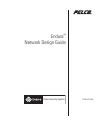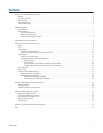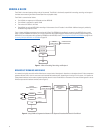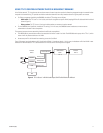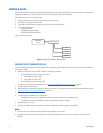8 C1640M-B (3/06)
– Sparse Mode is most useful in the following instances:
• There are few receivers in a group. Switches send multicast traffic only to the devices that request it.
• Senders and receivers are separated by Local Area Network (LAN) links.
• The type of traffic is intermittent.
PIM-SM is optimized for environments where there are many multipoint data streams. Each data stream is sent to a relatively small
number of the LANs in the internetwork. For these types of groups, Reverse Path Forwarding techniques waste bandwidth. PIM-SM
works by defining a rendezvous point. When a sender wants to send data, it first sends to the rendezvous point. When a receiver
wants to receive data, it registers with the rendezvous point. Once the data stream begins to flow from sender to rendezvous point to
receiver, the routers in the path will optimize the path automatically to remove any unnecessary hops. PIM-SM assumes that no hosts
want the multicast traffic unless they specifically ask for it.
PIM is able to simultaneously support dense mode for some multipoint groups and sparse mode for others.
• DVMRP: DVMRP is a routing protocol that supports multicast. Stemming from RIP and used in the Internet's Mbone (multicast backbone),
DVMRP allows for tunneling multicast messages within unicast packets. It also supports rate limiting and distribution control based on
destination address and is responsible for the following:
– Routes multicast datagrams
– Periodically floods multicast traffic (similar to PIM-DM)
– Allows use of non-multicast aware edge devices
INTERNET GROUP MANAGEMENT PROTOCOL
Internet Group Management Protocol (IGMP) is a communications protocol used to manage the membership of multicast groups. IGMP is a
required protocol in the Endura network and is used by IP hosts and adjacent multicast routers to establish multicast group memberships.
The specification that defines how to handle “unknown” multicast groups is not definitive. In this case, some vendors block multicast streams
that have no members, while other vendors will flood this same traffic. Flooding multicast streams that have no members can present a problem
in the Endura network because each video stream can be approximately 2 Mbps. In even a relatively small network, flooding Endura traffic can
significantly reduce network performance and the overall performance of the Endura system.
Endura Network Design Considerations
The Endura network is based on switching and routing technologies. When planning an Endura network, you need to know and understand the
difference between the traditional “Core” and “Intelligent Edge” network topology design approach.
• Traditional network design approach
The traditional network design topology is based on a central network core, which is responsible for all routing decisions. This approach
requires the use of high-performance and high-cost core network equipment. This approach will work if the specified core switch is capable
of managing all of the following:
– Making all of the unicast routing decisions
– Making all of the multicast routing decisions
– Handling all Endura network traffic: video, audio, PTZ, and UPnP
– Handling all other existing network traffic
This approach may meet your network design requirements. However this approach might not be as scalable as the intelligent edge design,
because the volume of network traffic can easily consume the capacity of the core switch.
If network expansion is a future goal, then the intelligent edge design offers a scalable networking solution.
• Intelligent edge design approach
The alternative to the traditional design is the intelligent edge design. This design is based on placing smart switches at the network edge,
which reduces the need for a centralized core to make all routing decisions. Instead of a single core switch managing all of the routing and
network traffic decisions, in the intelligent edge design, processing is distributed across all managed switches. The intelligent edge design
allows the network to scale because managed switches can be easily added to the network without burdening a single core switch.
As compared to the traditional design, the intelligent edge design does not use the concept of a “core switch.”



